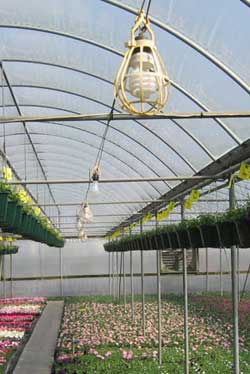Using CFLs to provide long days
Know the pros and cons of switching from incandescent to compact fluorescent lamps for long-day lighting.
|
A number of bedding plants and herbaceous perennials flower earlier under long days. Low-intensity light can be delivered during the night to create an artificially long day when the day length is naturally short, from September through March. Traditionally, growers have provided night-interruption lighting with incandescent lamps so that the minimum light intensity is around 10 footcandles (2 µmol∙m-2∙s-1). Incandescent lamps are effective at regulating flowering and are inexpensive to install, but they consume a lot of energy to operate.
Several growers have recently inquired about using compact fluorescent lamps (CFLs) to provide long days to their crops. The primary advantage of using CFLs instead of incandescent lamps is they consume about 4 times less energy. Therefore, 100-watt incandescents can be replaced by 25-watt CFLs and still deliver a similar light intensity. Of course, the light spectra emitted from the bulbs are different. In particular, incandescent lamps emit light that is rich in red and far-red light, whereas CFLs emit more blue and less far-red light.Several growers have recently inquired about using compact fluorescent lamps (CFLs) to provide long days to their crops. The primary advantage of using CFLs instead of incandescent lamps is they consume about 4 times less energy. Therefore, 100-watt incandescents can be replaced by 25-watt CFLs and still deliver a similar light intensity. Of course, the light spectra emitted from the bulbs are different. In particular, incandescent lamps emit light that is rich in red and far-red light, whereas CFLs emit more blue and less far-red light.
We investigated the flowering response of long-day floriculture crops grown under CFLs, incandescents, or a mix of the two. Some of the results of the study were published in a GrowerTalks article. In a nutshell, we learned that CFLs alone can be used effectively in many crops. However, in at least some crops such as Wave Purple Classic petunia, flowering under only CFLs was delayed compared to plants grown under incandescents or an equal mix of CFLs and incandescents. Therefore, when growing a variety of long-day crops, it’s probably safest to replace only every other incandescent lamp with a CFL. Growers who switch completely to CFLs may observe a flowering delay in some of their crops.For more information on lighting of floriculture crops, visit the lighting page of the MSU Floriculture website. Lists of long-day bedding plants and perennials can be found towards the end of the document “Use of Lighting to Accelerate Crop Timing” (Tables 3 and 4).
For more information on lighting of floriculture crops, visit the lighting page of the MSU Floriculture website. Lists of long-day bedding plants and perennials can be found towards the end of the document “Use of Lighting to Accelerate Crop Timing” (Tables 3 and 4).
Erik Runkle's work is funded in part by MSU's AgBioResearch.



 Print
Print Email
Email



